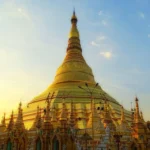
Nestled in the heart of Japan, Himeji Castle stands as a breathtaking symbol of the nation’s rich history and architectural prowess. Often referred to as “White Heron Castle” for its stunning white exterior that resembles a bird in flight, this UNESCO World Heritage Site has captivated visitors for centuries. With its intricate design, storied past, and cultural significance, Himeji Castle is more than just a picturesque landmark; it is a testament to Japan’s feudal era and the artistry of its craftsmen. In this blog, we will explore 25 fascinating facts about Himeji Castle, from its remarkable restoration efforts to the architectural features that make it a masterpiece of Japanese castle design. Whether you’re a history buff, an architecture enthusiast, or simply curious about this iconic site, these intriguing insights will deepen your appreciation for one of Japan’s most treasured gems. Join us as we uncover the secrets and stories behind Himeji Castle!
1333: The history of Himeji Castle begins in 1333 when a fort was first constructed on Himeyama hill by Akamatsu Norimura. This initial fortification served as a strategic military base, taking advantage of the elevated terrain to provide a defensive advantage against potential invaders. The choice of location was significant, as it allowed for better surveillance of the surrounding area and control of key routes. This early structure laid the groundwork for what would evolve into one of Japan’s most iconic castles.
1346: In 1346, Akamatsu Sadanori dismantled the original fort built by his predecessor and initiated the construction of the first proper castle buildings. This transition from a simple fort to a more complex castle structure marked an important evolution in Japanese castle architecture, reflecting advancements in military design and the increasing power of the Akamatsu clan. The new buildings incorporated stronger materials and more sophisticated architectural elements, paving the way for the future grandeur of Himeji Castle.
1601-1609: The most significant phase of Himeji Castle’s construction occurred between 1601 and 1609 under the direction of Ikeda Terumasa, who completed the majority of the castle complex that is visible today, including the iconic main keep. This period saw the integration of various architectural styles and defensive features, resulting in a castle that not only served military purposes but also showcased the wealth and power of its rulers. The main keep, with its distinctive white plaster walls and intricate rooflines, became a symbol of strength and elegance, reflecting the aesthetic values of the time.
83: Within the Himeji Castle complex, there are 83 buildings and structures that are designated as National Treasures or Important Cultural Properties of Japan. This designation underscores the castle’s historical and architectural significance, as these structures represent a blend of Japanese castle design and cultural heritage. The preservation of these buildings allows visitors to appreciate the craftsmanship and historical context of the era, making Himeji Castle a vital part of Japan’s cultural landscape.
46.4 meters (approx. 152 ft): The total height of the main keep, or Dai-Tenshu, measures 46.4 meters (approximately 152 feet) from the top of its stone base to the roof ridge. This impressive height not only contributes to the castle’s striking silhouette against the skyline but also serves practical purposes in defense and visibility. The elevation allows for better surveillance of the surrounding landscape, enhancing its strategic military function while also symbolizing the power of the ruling class.
6: The main keep of Himeji Castle features six floors, each designed with specific functions and architectural elements. These floors include living quarters, storage areas, and defense mechanisms, reflecting the multi-faceted role of the castle as both a residence and a military stronghold. The layout of the floors is thoughtfully arranged to optimize space and security, with narrow staircases and hidden passages that would have been crucial during times of conflict.
1: Beneath the main keep lies one basement level, making the total count of stories six above ground plus one basement. This basement level was strategically designed for storage and possibly as a refuge during sieges. The inclusion of a basement also demonstrates the careful planning involved in castle construction, allowing for a more complex and functional design that met the needs of its inhabitants while enhancing its defensive capabilities.
5: The main keep is characterized by its five tiers or external roof levels, which contribute to its distinctive appearance. This tiered design is not only aesthetically pleasing but also serves practical purposes, such as improving drainage and reducing wind resistance. The complexity of the roof structure showcases the advanced architectural techniques of the time and adds to the castle’s grandeur, making it a prominent feature of Himeji’s skyline.
2: Two massive, principal wooden pillars known as the East Pillar and West Pillar run through the center of the main keep, providing essential structural support. These pillars are integral to the stability of the building, allowing it to withstand the test of time and natural elements. Their presence highlights the engineering ingenuity of the castle’s builders, who understood the importance of strong foundations in creating a lasting structure.
1993: Himeji Castle was registered as one of Japan’s very first UNESCO World Heritage Sites in 1993, specifically on December 11th. This recognition acknowledges the castle’s outstanding universal value and its importance as a cultural landmark. Being designated as a UNESCO site has helped to raise awareness of Himeji Castle’s historical significance and has contributed to its preservation efforts, ensuring that future generations can appreciate its beauty and heritage.
107 hectares (approx. 264 acres): The total area included within the designated UNESCO World Heritage site boundary is approximately 107 hectares (about 264 acres). This expansive area encompasses not only the castle itself but also the surrounding gardens, moats, and various historical structures that contribute to the overall cultural landscape. The large site allows for a comprehensive understanding of the castle’s historical context, showcasing how it interacted with its environment and the community around it. This designation helps protect the site from modern development and ensures that its historical integrity is maintained.
12: Himeji Castle is one of only twelve castles in Japan that retain their original, pre-1868 keeps (tenshu). This fact highlights the castle’s significance as a rare example of traditional Japanese architecture that has survived the tumultuous periods of history, including wars and natural disasters. The preservation of these original keeps offers invaluable insights into the architectural styles and defensive strategies employed during the feudal era, making Himeji Castle an essential site for understanding Japan’s cultural heritage.
1931: In 1931, various structures within the castle complex, excluding the main keep initially, were first designated as National Treasures under the earlier 1897 law. This designation marked a critical step in the recognition of the castle’s historical and cultural importance, leading to increased efforts for its preservation. The classification as National Treasures not only helps protect these structures but also raises public awareness about their significance, encouraging conservation and educational initiatives.
1951: The main keep complex, which includes the main keep and its connected smaller keeps and corridors, was designated as a National Treasure in 1951 under the current 1950 Cultural Properties Protection Law. This designation underscores the national importance of the main keep as a masterpiece of Japanese castle architecture. It also facilitates funding and resources for ongoing preservation efforts, ensuring that this iconic structure remains intact for future generations to explore and admire.
3: Himeji Castle features three smaller subsidiary keeps, known as Kotenshu, which are directly connected to the main keep via corridors (Watari-yagura). These subsidiary keeps served various functions, including additional living quarters and defense mechanisms. The architectural design of these connected structures reflects the strategic planning that went into the castle’s layout, allowing for efficient movement and communication between different parts of the complex while enhancing its overall defensive capabilities.
21: Of the original estimated 84 castle gates, 21 still survive within the grounds of Himeji Castle today. These gates are significant not only for their architectural features but also for their historical role in controlling access to the castle. Each gate was designed with defensive features, such as narrow passages and heavy doors, to protect against intruders. The survival of these gates offers a glimpse into the castle’s security measures and the importance of fortifications in feudal Japan.
45.6 meters (approx. 150 ft): The stone base (tenshudai) on which the main keep stands is approximately 45.6 meters (about 150 feet) above sea level. This elevation provides a strategic advantage, as it enhances the visibility of the castle from the surrounding landscape. The height of the stone base also contributes to the castle’s imposing presence, making it a formidable sight for anyone approaching. The careful selection of this elevated site demonstrates the military foresight of the castle’s builders.
15 meters (approx. 49 ft): The sloping stone base (tenshudai) that supports the main keep stands at an approximate height of 15 meters (around 49 feet). This impressive elevation not only serves aesthetic purposes but also enhances the castle’s defensive capabilities by making it harder for attackers to reach the main structure. The design of the stone base reflects the architectural sophistication of the time, combining functionality with visual appeal.
1956-1964: The “Great Showa Restoration” took place from 1956 to 1964, involving extensive work to completely dismantle and reassemble the main keep to ensure its long-term preservation. This restoration was necessitated by the need to address structural issues and to preserve the castle’s integrity. The meticulous process required skilled craftsmanship and a deep understanding of traditional building techniques, demonstrating a commitment to maintaining the historical authenticity of the castle while ensuring its safety for future generations.
550 million Yen: The approximate cost of the Great Showa Restoration (1956-1964) was around 550 million Yen. This significant investment reflects the importance placed on preserving Himeji Castle as a national treasure and cultural icon. The funds were used not only for structural repairs but also for restoring the castle’s original aesthetic features, ensuring that the restoration was both functional and faithful to the castle’s historical design.
Great Heisei Restoration (2009-2015): The “Great Heisei Restoration” of Himeji Castle was a significant undertaking that lasted from 2009 to 2015, focusing primarily on the preservation and restoration of the castle’s external features. This extensive project involved re-plastering the castle’s iconic white walls, which are made from a traditional technique that uses a mixture of clay, sand, and lime. The restoration aimed to maintain the castle’s structural integrity while enhancing its aesthetic appeal. The careful replacement of roof tiles was also a key component, ensuring that the traditional architectural style was preserved. The project was completed in March 2015, allowing visitors to once again enjoy the full splendor of this UNESCO World Heritage Site, which is often referred to as “White Heron Castle” due to its elegant, white exterior.
Cost of the Great Heisei Restoration (2.4 billion Yen): The financial investment required for the Great Heisei Restoration was approximately 2.4 billion yen. This substantial budget was allocated to cover various aspects of the restoration process, including labor, materials, and the use of traditional construction techniques that are essential for maintaining the castle’s historical authenticity. The funding was sourced from both public and private sectors, reflecting the cultural significance of Himeji Castle to Japan. The restoration not only aimed to preserve the castle for future generations but also to enhance its role as a major tourist attraction, contributing to local and national pride.
Record Visitors (2,867,387): Himeji Castle achieved a remarkable milestone in fiscal year 2015, recording 2,867,387 visitors, the highest number in its history. This surge in attendance can be attributed to the completion of the Great Heisei Restoration, which drew both domestic and international tourists eager to witness the castle in its restored glory. The increase in visitor numbers highlights the castle’s importance as a cultural and historical landmark in Japan, as well as its appeal as a tourist destination. The influx of visitors not only boosts the local economy but also fosters greater appreciation for Japan’s rich heritage and architectural accomplishments.
Nishi-no-maru Nagatsubone (240 meters): The Nishi-no-maru Nagatsubone, often referred to as the “Long Corridor” or “Warriors’ Barracks,” stretches approximately 240 meters (about 787 feet) within the West Bailey of Himeji Castle. This impressive structure served as a vital area where ladies-in-waiting and other personnel could move about while remaining protected from the elements and potential threats. The corridor’s design reflects the castle’s strategic planning, allowing for efficient movement and communication among its inhabitants. Its length and architectural features showcase the ingenuity of Japanese castle design, blending functionality with aesthetic beauty, making it an important part of the castle’s overall layout.
Narrow Escape from Destruction (1945): In 1945, Himeji Castle narrowly escaped destruction during World War II when an incendiary bomb fell through the roof of the main keep. The bomb, which was part of the Allied bombing campaign, failed to ignite properly, thus sparing the castle from the devastating fire that consumed many other historical structures during the war. This fortunate incident is often regarded as a miraculous event, emphasizing the castle’s resilience and the importance of preserving such cultural heritage. The close call serves as a reminder of the castle’s historical significance and the need for ongoing preservation efforts to ensure that future generations can continue to appreciate this architectural masterpiece.
Frequently Asked Questions about Himeji Castle:
- What is Himeji Castle known for? Himeji Castle is renowned for its stunning architectural beauty, historical significance, and well-preserved structure. It is one of Japan’s most famous castles and is often referred to as “White Heron Castle” due to its elegant white exterior. The castle is a UNESCO World Heritage Site and is celebrated for its intricate design, which combines both defensive features and aesthetic appeal. It showcases traditional Japanese castle architecture, including its complex layout of walls, gates, and towers, making it a prime example of feudal-era construction.
- When was Himeji Castle built? Himeji Castle was originally constructed in 1346, during the Muromachi period, as a small fort. However, it underwent significant expansions and renovations in the following centuries, particularly in the early 1600s under the guidance of the samurai lord Ikeda Terumasa. The castle reached its current form around 1609, showcasing the architectural advancements of the time. Its construction reflects the military and political dynamics of feudal Japan, serving as a strategic stronghold.
- How can I visit Himeji Castle? Himeji Castle is accessible to visitors year-round, and it is located in Himeji City, Hyogo Prefecture. The easiest way to reach the castle is by taking a train, with the Himeji Station being the closest major transport hub. From the station, it’s about a 15-20 minute walk to the castle grounds. Visitors can purchase tickets at the entrance, and it’s advisable to check for any seasonal events or guided tours that may enhance the experience. The castle also has beautiful gardens and surrounding areas that are worth exploring.
- Is there an entrance fee for Himeji Castle? Yes, there is an entrance fee to visit Himeji Castle. As of October 2023, the general admission fee is approximately 1,000 yen for adults, while discounts may apply for children and seniors. It’s important to check the official Himeji Castle website or local tourism information for the most current pricing and any special promotions. The ticket grants access to the castle grounds, the main keep, and various exhibitions that showcase the castle’s history and architecture.
- What are the key features of Himeji Castle? Himeji Castle boasts several key features that highlight its architectural significance. The main keep (tenshu) is a multi-storied structure with a distinctive curved roof and intricate wooden framework. The castle complex includes defensive elements such as moats, stone walls, and watchtowers designed to deter invaders. The Nishi-no-maru Nagatsubone, or “Long Corridor,” is another notable feature, providing a protected passageway within the castle grounds. The beautifully landscaped gardens surrounding the castle add to its charm, especially during cherry blossom season.
- What is the Great Heisei Restoration? The Great Heisei Restoration was a major restoration project that took place from 2009 to 2015, focusing on the preservation and repair of Himeji Castle. This extensive undertaking involved re-plastering the castle’s exterior walls and replacing roof tiles to maintain the structure’s historical integrity. The restoration aimed to address wear and tear while enhancing the castle’s aesthetic appeal. The project was completed in March 2015 and has since contributed to a significant increase in visitor numbers, showcasing the castle in its restored glory.
- Has Himeji Castle ever been damaged? Yes, Himeji Castle has faced threats from natural disasters and wartime events. Notably, it narrowly escaped destruction during World War II when an incendiary bomb fell through the roof of the main keep in 1945 but failed to ignite. Additionally, the castle has experienced damage from earthquakes over the centuries, prompting ongoing preservation efforts to ensure its survival. The restoration projects, including the Great Heisei Restoration, have been crucial in maintaining the castle’s structural integrity and historical significance.
- What can visitors expect to see inside Himeji Castle? Inside Himeji Castle, visitors can explore several areas, including the main keep, which houses exhibitions on the castle’s history, architecture, and the samurai culture of the era. The interior features wooden beams, tatami mat flooring, and steep staircases leading to various levels. Visitors can enjoy panoramic views of the surrounding city and landscape from the top of the main keep. The castle grounds also include gardens, moats, and other historical structures, providing a comprehensive experience of the castle’s rich heritage.
- Are there any events or festivals held at Himeji Castle? Yes, Himeji Castle hosts various events and festivals throughout the year, attracting both locals and tourists. One of the most popular events is the Himeji Cherry Blossom Festival, which takes place in spring when the cherry trees around the castle bloom spectacularly. Visitors can enjoy hanami (flower viewing) picnics in the castle grounds, making it a vibrant and picturesque celebration of nature. Additionally, the castle often holds historical reenactments, cultural performances, and exhibitions that showcase traditional Japanese arts and crafts. These events provide an immersive experience, allowing visitors to engage with the rich cultural heritage of the region.
- Is Himeji Castle accessible for people with disabilities? Himeji Castle has made efforts to improve accessibility for visitors with disabilities. While the castle’s historical architecture presents some challenges, there are designated pathways and ramps to assist those with mobility issues. Additionally, staff members are available to provide assistance as needed. It is advisable for visitors to check in advance with the castle’s official website or visitor information centers for the most up-to-date details on accessibility options and available services.
- Can I take photos inside Himeji Castle? Yes, photography is generally allowed inside Himeji Castle, but visitors are encouraged to be respectful of the space and other guests. Some areas may have restrictions on photography, particularly in exhibition spaces, so it’s important to pay attention to signage. Capturing the stunning architecture and beautiful surroundings is a popular activity for many visitors, and the castle offers numerous picturesque backdrops.
- What is the best time to visit Himeji Castle? The best time to visit Himeji Castle is during the spring (March to May) and autumn (September to November) seasons. Spring is particularly famous for the cherry blossoms, which create a breathtaking scene around the castle. Autumn brings vibrant fall foliage, enhancing the castle’s beauty. Visiting during these seasons allows for pleasant weather and stunning natural scenery. However, Himeji Castle is open year-round, and each season offers a unique perspective of this historical landmark.
- Are there guided tours available at Himeji Castle? Yes, guided tours are available for visitors who wish to learn more about Himeji Castle’s history and architecture. These tours are often conducted by knowledgeable guides who provide insights into the castle’s construction, historical significance, and cultural context. Audio guides are also available for those who prefer a self-guided experience. It’s a great way to deepen your understanding of the castle and its many fascinating stories.
- What should I wear when visiting Himeji Castle? When visiting Himeji Castle, it is advisable to wear comfortable clothing and sturdy shoes, as the castle grounds and interior involve walking and climbing stairs. The castle’s architecture includes steep staircases, particularly in the main keep, so supportive footwear is essential. Depending on the season, visitors should also dress appropriately for the weather, with layers being a good option in cooler months. Sun protection, such as hats and sunscreen, is recommended during the summer months when the sun can be quite strong.
- Is there a gift shop or dining options at Himeji Castle? Yes, Himeji Castle features gift shops where visitors can purchase souvenirs, including traditional crafts, local snacks, and castle-themed merchandise. These shops often highlight the culture and history of Himeji and Japan. Additionally, there are dining options available nearby, including restaurants and cafes that offer local cuisine and refreshments. Visitors can enjoy a meal or snack while taking in the beautiful views of the castle and its surroundings.








